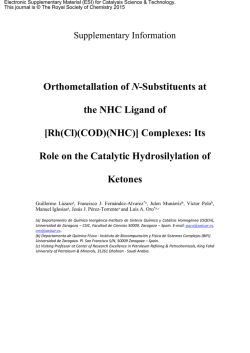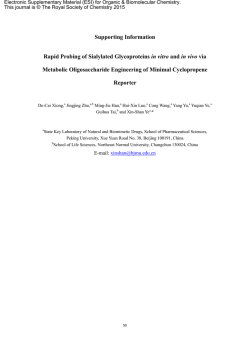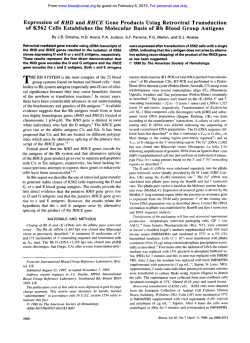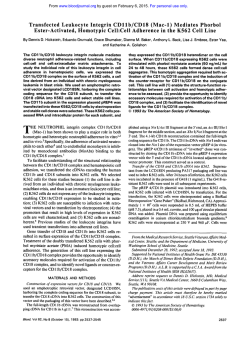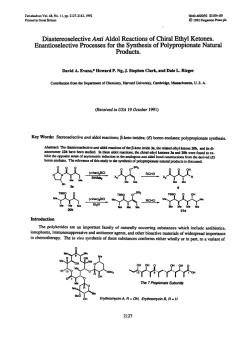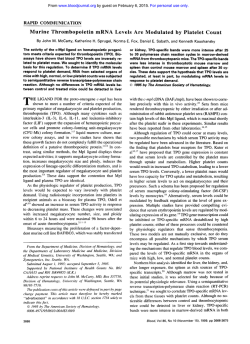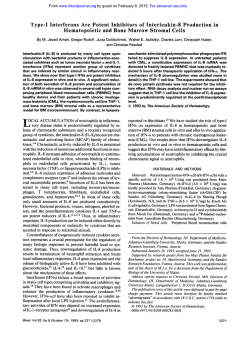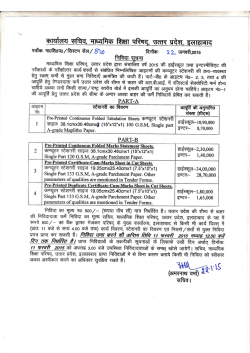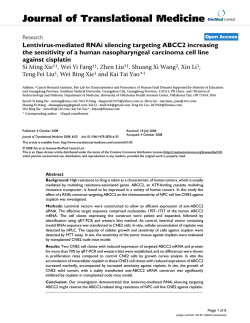
The Effect of Redox-Related Species of Nitrogen Monoxide
From www.bloodjournal.org by guest on February 6, 2015. For personal use only. The Effect of Redox-Related Species of Nitrogen Monoxide on Transferrin and Iron Uptake and Cellular Proliferation of Erythroleukemia (K562)Cells By D.R. Richardson, V. Neurnannova, E. Nagy, and P. Ponka The iron-responsiveelement-bindingprotein (IRE-BP)modulates both ferritin mRNA translation and transferrin receptor (TfR) mRNAstability by binding t o specific mRNA sequences called iron-responsive elements (IRES). The regulation of IREBP in situ auld possibly occur either through its Fe-S cluster and/or via free cysteine sulphydryl groups such as cysteine 437 (Philpott et al, J Biol Chem 268A7655.1993; and Hirling et al, EMBO J 13:453, 1994). Recently, nitrogen monoxide (NO) has been shown t o have markedly different biologic effects depending on its redox state (Lipton et al. Nature 364626, 1993). Considering this fact, it is conceivable that the NO group, as either the nitrosonium ion (NO') or nitric oxide (NO), may regulate IRE-BP activity by S-nitrosylation of key sulphydryl groups or via ligation of N O t othe FeS cluster, respectively. This hypothesis has been examined using the NO+ generator, sodium nitroprusside (SNP); the N O generator, S-nitroso-N-acetylpenicillamine(SNAP); and the NO/peroxynitrite (ONOO-) generator, 3-morpholinosydnonimine hydrochloride (SIN-l). Treatment of K562 cells for 18 hours with SNP (1mmol/L) resulted in a pronounced decrease in boththe RNA-bindingactivity of IRE-BP and the level of TfR mRNA. In addition, Scatchard analysis showed a marked decrease in the number of specific Tf-binding sites, from 590,00O/cell (control) t o 170,000/cell (test), and there was also adistinct decrease in Fe uptake. Furthermore, SNP did not decrease cellular viability or proliferation. In contrast, the N O generator, SNAP(1 mmol/L), increased RNA-binding activity of IRE-BP, the level of TfR mRNA, and the number of TfRs in K562 cells. Moreover, both SNAP (1mmol/L) and SIN-l (0.5 mmol/L) reduced cellularproliferation. The resutts are discussed in context of the possible physiologic role of redox-related species of NO in regulating iron metabolism. 0 1995 by The American Society of Hematology. T aconitase.'4.'5 Therefore, similar to aconitase, the biologic activity of IRE-BP may be modulated by NO; in fact, Drapier et a l l 6 and Weiss et al" have shown that NO can activate IRE-BP RNA-binding activity. However, these investigators did not consider the effects of redox-related species of NO on IRE-BP or TW expression and Fe uptake. Considering the possible target sites of NO on the IREBP molecule, it has been shown that in Fe replete cells IREBP possesses a cubane 4Fe-4s cluster that prevents IRE binding, and, in this state, the protein displays aconitase activity. In contrast, in cells depleted of Fe, the Fe-S cluster is not present, and, under these conditions, IRE-BP can bind to the IRE of mRNA.'53'S*'9 In addition, a free cysteine sulphydryl group(s) also appears to regulate the binding of IREBP to mRNA.'@'* However, the relative roles of the FeS cluster and sulphydryl group(s) in IRE-BP regulation are not well understood. RANSFERRIN RECEPTOR (TW) and ferritin synthesis are under coordinate regulation by intracellular iron (Fe) concentration.' This level of coordinate control occurs at the posttranscriptional level and is mapped to regions on TW and ferritin mRNA known as the iron-responsive elements (IREs).**~ The IREis recognized by a specific cytoplasmic binding protein known as the IRE-binding protein (IRE-BP). Cells depleted of Fe contain higher levels of activated IRE-BP, which forms stable complexes with the IRE. When IRE-BP binds to the IRE of ferritin mFWA, it represses its tran~lation?~ whereas IRE-BP binding to the IRE of TfR mRNA protects the message from degradati~n.~.' Either a decrease in intracellular Fe concentration or reducing conditions activate RNA-binding ofIRE-BP, but the mechanism of this regulation in situ is unclear. A variety of nitrogen oxides are produced in mammalian cells that serve messenger roles.8 Nitrogen monoxide (NO) has been shown to have markedly different biologic effects in neural cells depending on its redox state.9 Nitric oxide (NO) has a neurotoxic effect by reacting with superoxide anion to produce peroxynitrite (ONOO-). In contrast, the nitrosonium ion (NO+), has a neuroprotective effect via Snitrosylation of thiol groups on the N-methyl-D-aspartate r e ~ e p t o rFurthermore, .~ both NO+ and N O have been shown to regulate the biologic activity of proteins under physiologic circumstances, and nitric oxide synthase could produce both chemical species under different intracellular redox conditions." However, because of the unique chemical properties of NO and NO, these two redox-related species ofNO react at different target sites on protein molecules. For example, numerous proteins can be S-nitrosylated by NO+ via their thiol groups, a modification that may have important physiologically relevant regulatory functions.9-" On the other hand, N O can modulate protein activity via direct coordination to the Fe centers of prosthetic groups, such as heme and Fe-S clusters.'o One example of an Fe-S protein whose activity is modulated by NO is the Krebs cycle enzyme, mitochondrial Interestingly, IRE-BP, which is present in the cytosol, has high homology to mitochondrial aconitase and has been described as a cytoplasmic Blood, Vol 86, No 8 (October 15). 1995: pp 3211-3219 From the Lady Davis Institute for Medical Research of the Sir Mortimer B. Davis-Jewish General Hospital, Montreal, Quebec, Canada; and the Departments of Medicine and Physiology, McGill University, Montreal, Quebec, Canada. Submitted July 5, 1994; accepted June 12, 1995. Supported by an operating grant from the Medical Research Council of Canada. D.R.R. is the recipient of a Medical Research Council of Canada Postdoctoral Fellowship. V.N. is the recipient of a Bertha Mime Fellowshipfrom the Sir-Mortimer B. Davis Jewish General Hospital, Montreal, Canada. Presented in part at the 11th International Conference on Iron and Iron Storage Proteins, Jerusalem, Israel, May 5, 1993, and also at The American Society of Hematology meeting, December 1993 (Blood 82:9a, 1993 [abstr, suppl l ] ) . Address reprint requests toP. Ponka, MD, PhD, Lady Davis Institute for Medical Research, Sir Mortimer B. Davis-Jewish General Hospital, 3755 Chemin de la Cote-Ste-Catherine, Montreal, Quebec, H3T IE2 Canada. The publication costs of this article were defrayed in part by page charge payment. This article must therefore be hereby marked "advertisement" in accordance with 18 U.S.C. section 1734 solely to indicate this fact. 0 1995 by The American Society of Hematology. 0006-4971/95/8608-0017$3.OO/0 321 1 From www.bloodjournal.org by guest on February 6, 2015. For personal use only. 3212 RICHARDSON ET AL It is conceivable that NO, as either NO+ or N O , may regulate IRE-BP activity via S-nitrosylation of key sulphydryl groups or via ligation of N O to the Fe-S center of the protein. This hypothesis has been examined in the present study using the NO+ generating drug, sodium nitroprusside9*’’; the N O generator, S-nitroso-N-acetylpenicillamine (SNAP)23; and the NO/ONOO- generator, 3-morpholinosydnonimine hydrochloride (SIN-l).9 The effects of these agents on IRE-BP activation, TW expression, Fe uptake, and cellular proliferation have been examined in K562 erythroleukemia cells. MATERIALS ANDMETHODS Chemicals. Iron-59 chloride (as ferric chloride in 0.1 m o m HCI), iodine-l25 (as sodium iodide), and [a-3zP]-CTP (800 Ci/ mmol) were purchased from Dupont (NEN Products, Boston, MA). Human transfemn and T7 RNA polymerase was purchased from Boehringer Mannheim (Mannheim, Germany). RNase TI was obtained from Calbiochem (San Diego, CA). Penicillin-streptomycin was obtained from GIBCO Laboratories Ltd (Grand Island, NY). N-2-hydroxyethylpiperazine-N’-2-ethanesulfonic acid (HEPES), bovine liver catalase (EC 1.1 1.1.6), bovine erythrocyte superoxide dismutase (EC 1.15.1.1), N-acetyl-D-penicillamine(NAP), sodium pyruvate, and L-glutamine were obtained from Sigma Chemical CO (St Louis, MO). RPMI-1640 medium and fetal calf serum (FCS) were obtained from ICN Biomedicals Inc (Costa Mesa, CA). Desferrioxamine (DFO) was obtained from Ciba-Geigy Pharmaceutical CO (Summit, NJ). All other chemicals were of analytical reagent quality. Nitrogen monoxide generating compounds. SNAP was synthesized from NAP according to the method of Field et al.z4 SIN-l and its inactive analogue, SIN-IC, were kind gifts from Dr Rainer Henning (Cassella, A.G., Frankfurt, Germany). Sodium nitroprusside was obtained from Sigma Chemical Co. All chemicals were added to RPMI medium immediately before an experiment and all solutions were prepared in containers wrapped in aluminium foil. This latter procedure was adopted to prevent photolysis of the compounds in solution.23For each of the experiments listed below, cells were exposed for 1 to 18 hours with the NO donors dissolved in RPMI medium without 10% FCS. Cells. Human K562 erythroleukemia cells were obtained from the American Type Culture Collection (Rockville, MD) and were used inthe present study because their Fe metabolism is well characterized.zs-27 Cells were grown in 25-cmZplastic culture flasks (Costar, Cambridge, MA) in an humidified atmosphere of 95% air and 5% COn at 37°C in RPMI-1640 containing 10%FCS, extra L-glutamine (300 pg/mL), sodium pyruvate (110 pg/mL), HEPES (15 mmoVL; pH 7.2), penicillin (100 U/mL), and streptomycin (100 pg/mL). The cells were maintained in log-phase growth at approximately 5 to 8 x io5 cells/mL. Human transferrin. Human apoTf was prepared and labeled with 59Feand In5I, as described previously.z8 Gel-rerardntion assay. The gel-retardation assay wasusedto measure the interaction between IRE-BP and the IRE using established te~hniques.4’~ Briefly, after incubation with RPMI alone (control) or various NO’/NO producing agents, 5 X IO6 cells were washed with ice-cold phosphate-buffered saline (PBS) and lysed at 4°C in 100 pL of extraction buffer (10 mmoVL HEPES, pH 7.5, 3 mmol/L MgCln,40 mmol/L KCI, 5% glycerol, 1 mmol/L dithiothreitol, and 0.2% Nonidet P-40). After lysis, the samples were then centrifuged at 10,000g for 3 minutes to remove nuclei. Samples of cytoplasmic extracts were diluted to a protein concentration of 100 pg/mL in lysis buffer without Nonidet P-40, and 2 pg aliquotes were analyzed for IRE-BP by incubation with 0.1 ng of 32Plabeled pSPT-fer RNA transcript.” RNA was transcribed in vitro from linearized plasmid templates using T7 RNA polymerase in the presence of [w3’P CTP]. TO form RNA-protein complexes, cytoplasmic extracts were incubated for IO minutes at room temperature with 0.1 ng of labeled RNA. Unprotected probe was degraded by incubation with l U of RNAse TI for I O minutes. Heparin (5 mg/mL) was then added for another IO minutes to exclude nonspecific binding. RNA-protein complexes were analyzed in 6% nondenaturing polyacrylamide gels as described by Konarska and Sharp.3”In parallel experiments, samples were treated with 2% 2-mercaptoethanol before the addition of the RNAprobe. Autoradiographs were quantified by scanning densitometry. Northern blot analysis. Briefly, Northern blot analysis was performed by isolating total RNAvia cell solubilization in a buffer containing acid guanidinium thiocyanate, followed by phenol extraction and ethanol precipitation.” RNA wasquantitated by spectrophotometry at a wavelength of 260 nm and its quality was checked by ethidium bromide staining on nondenaturing I % agarose gels. RNA samples were denatured by heating at 65°C for 10 minutes and 15 pg ofRNAwas then loaded onto 1.2% agarose gels containing formaldehyde. After electrophoresis, RNA was transferred to nitrocellulose filters using the capillary blotting method. The filters were air-dried, bakedin a vacuum oven at 80°C for 2 hours, andthen hybridized with the human TW probe (pCDTR1; obtained from Dr Frank Ruddle, Yale University, New Haven, CT) and P-actin probe (cDNA obtained from Dr Lee Wall, Institut du Cancer de Montreal, Hopital Notre Dame, Montreal, Quebec, Canada). Hybridizations were performed as described by Meinkoth and Wahl” at 42°C overnight in hybridization solutions (50% [voUvol] formamide, 0.1% polyvinylpyrrolidone, 0.1% Ficoll400, 0.1% bovine serum albumin [BSA], 0.1% sodium dodecyl sulfate [SDS], 5X SSPE [lX SSPE is 0.15 molL NaC1,O.Ol mol/L NaH2POCHz0,and 1 mmom EDTA, sodium salt], 10% [wt/vol] dextran sulphate, and200 pglmL of denatured hemng sperm DNA) containing 3zP-labeledprobes prepared usingthe random primed DNA labeling kit (Boehringer Mannheim). The filters werethenwashed according tothemethod of Maniatis et al.” Densitometric data were collected withanLKB 2222-020 UltroScan XL Laser Densitometer and data analyzed by GelScan XL Software (Uppsala, Sweden). Transferrinand iron uptake. For Tf and Fe uptake studies, K562 cells were collected by centrifugation at 500g for 5 minutes and then washedinbasicRPM1medium containing no serum. After this procedure was performed, the cells were exposed to the NO’ generator, SNP (1 mmom), or the N O generator, SNAP (1 mmol/ L), for 18 hours at37°C. Transferrin andFe uptake studies were then performed by standard techniques described previously.’* Briefly, after exposure to NO-generating agents, the medium was replaced and the cells were resuspended in RPMI containing 59Fe‘”I-transfemn (Tf; 1 to 40 pg/mL). Cells (3 X 10‘ per Tf concentration) were incubated with doubly labeled Tf for 2 hours at37°C and then washed three times at 4°C with ice-cold PBS to remove nonspecifically bound 59Fe-1251-Tf. In no case was FCS added to the preincubation medium containing NO-generating agents or tothe labeling solution. Scatchard analysis was performed using standard techniques.2RIt is important to note that, because the incubations were performed at 37”C, the calculated number of Tf-binding sites represents total binding. The ’Z51-Tf-labeledK562 cells were also further processed to estimate the numbers of internalized transfemnbinding sites. This was achieved by incubating the cells for 30 minutes at 4°C with pronase ( 1 mg/mL), followed by centrifugation to separate membrane-bound (supernatant) from internalized radioactivity in the cell elle et.'^.^^ However, after treatment with pronase, the cell pellet became gelatinous, thus preventing complete separation of the supernatant from the cells. Hence, this latter technique was not used further. OF From www.bloodjournal.org by guest on February 6, 2015. For personal use only. EFFECT NO ON CELLULAR IRON METABOLISM Radioactivity was measured in a gamma scintillation counter with appropriate correction for overlap of "Fe activity into the '"I channel. Effect of NO' and NO' donors on cellular proliferation. The effect of NO' and NO' donors on cellular proliferation was assessed after 18 hours of incubationwith these agents usingviable cell counts. RESULTS The effect of NO', NO' and NO'/ONOO- donors on IREBP RNA-binding activity and T P mRNA. Initial studies examined the effect of incubating K562 cells for 18 hours with the NO' donor, SNP. Increasing concentrations of SNP (0.1,1,and 5 mmol/L; lanes 2, 3, and 4, respectively, of Fig1A) decreased IRE-BP RNA-binding activity compared with that ofthe control (lane 1, Fig 1A), but did not decrease total IRE-BP (data not shown). In addition, the decrease in IRE-BP binding activity was accompanied by a marked decrease in the level of TfR mRNA (Fig 1B).As shown previously by other^,^^.^^ DFO (50 pmol/L, lane 5) increased IRE-BP RNA-binding activity (Fig 1A) and TfR mRNA levels (Fig 1B). The addition of increasing concentrations of SNP (0.1, 1, and 5 mmol/L; lanes 6,7, and 8, respectively) to DFO (50 pmoVL) substantially prevented the increase in the RNA-binding activity of IRE-BP seen in the presence of DFO alone and also prevented the DFO-mediated increase in TfR mRNA. In addition, it should be noted that SNP only totally overcame the inducing effects of DFO when the molar ratio of SNP to DFO was greater than two (see also Fig 4, lanes 6 and 7). Further experiments examined the effect of SNP (1 mmoVL) compared with DFO (1 mmol/L) on TfR mRNA after 0 to 18 hours of incubation with these agents (Fig 2). The effect of SNP at decreasing TfR mRNA was evident already after only 1 hour of incubation with this compound, with the result becoming more pronounced as the incubation was continued up to 4, 8, and 18 hours (Fig Fig 1. Changes in (A) the RNA-binding activity of IRE-BP and (B) TfR mRNA levels in K562 cells incubated for 18 hours with RPM1 (untreated control, lane 1); the nitrosonium ion (NO') generator, SNP (0.1,1, and 5 mmol/L; lanes 2,3,and 4, respectively); DFO (50 pmoll L, lane 5); or DFO (50 pmollL) plus SNP (0.1. 1, and 5 mmollL; lanes 6,7, and 8, respectively). 3213 2). Importantly, when compared with the relevant control (C) at each time point, SNP had no significant effect on pactin mRNA levels (Fig 2). The decomposition of SNP (Na2[Fe(CN)sNO].2H20)in solution leads to the production ofNO', ferricyanide, and cyanide (CN-).9.'".37Hence, control experiments weredesigned to investigate whether either CN- or ferricyanide could result in a decrease in IRE-BP RNA-binding activity and a decrease in TfR expression. Treatment of K562 cells with increasing concentrations of ferricyanide (0.5, 1, and 5 mmoI/L; lanes 2, 3, and 4, respectively, Fig 3) had little effect on IRE-BP binding activity (Fig 3A) but resulted in an increase in the level of TfR mRNA (Fig 3B). In contrast to the results obtained with ferricyanide, cyanide ( 1 mmol/ L) hadno effect on IRE-BP RNA-binding activity or the level of TfR mRNA (results not shown). Because SNP is an Fe complex, it was also possible that treatment of cells with SNP could lead to the donation of Fe and result in a decrease in IRE-BP binding activity and TfR mRNA. However, because ferricyanide did not decrease the RNA-binding activity of IRE-BP or TfR mRNA levels (Fig 3A and B), Fe donation to the cells via SNP could not explain the observed decrease in the RNA-binding activity of IRE-BP. Moreover, the addition of the impermeable Fe chelator, EDTA (1 mmoVL), to SNP (1 mmol/L) didnot prevent the decrease in IRE-BP RNA-bindingactivity or TfR mRNA (compare lane 3 [SNP] with lane 4 [SNP + EDTA]; Fig 4A and B), further suggesting that the effect of SNP was not due to Fe donation to the cell. The effect of the NO' donor, SNP (1 mmoVL), on IREBP binding activity and TfR mRNA was compared with that of the NO/ONOO- donor, SIN-l (Fig 4). SIN-l (lane 2, Fig 4A) only slightly reduced IRE-BP RNA-binding, whereas SIN-IC, a SIN-l analogue without the N-NO group, had no effect on IRE-BP binding activity when compared with the control. After treatment of K562 cells with SIN-l (1 mmoVL), TfR mRNA was decreased (lane 2, Fig 4B). However, SIN1 generates both N O and superoxide: resulting in the formation of ONOO-, which has been proposed to initiate lipid peroxidation and cytotoxicity.9.38 Hence,the results obtained with this compound may be due to these effects. Considering the cytotoxicity of ONOO- generated by SIN- 1, wecompared the effects of the N O generator, SNAP, with those of SIN-l alone or SIN-l added in combination with superoxide dismutase (SOD; 500 U/mL) and catalase (CAT; 500 U/mL). The addition of SOD to SIN-l prevents the generation of ONOO- by scavenging superoxide, and, under these conditions, SIN-l acts as an N O generator? We conducted six independent experiments of this type, all of which yielded similar results; one representative experiment is shown in Fig 5. Treatment of K562 cells with increasing concentrations of SNAP (0.1. 0.5, and 1 mmoVL, lanes 2, 3, and 4, Fig 5A and B) resulted in an increase in the IREBP RNA-binding activity (Fig 5A) and TfR mRNAlevel (Fig 5B) at SNAP concentrations of 0.5 mmol/L and 1 mmol/ L. In contrast, N-acetylpenicillamine (NAP), the precursor of SNAP that does not contain the S-NO group, did not affect the RNA-binding activity of IRE-BP (results notshown). From www.bloodjournal.org by guest on February 6, 2015. For personal use only. 3214 ET 08 h C S 4 h D l h C RICHARDSON 18 h S D C ~ S D C S D C S Fig 2. The effectofincubation time(0,1,4,8, and 18 hours) with RPM1 (untreatedcontrol; C), D ~~ Tf R ?mm9 Moreover, none of the agents tested in our study decreased total IRE-BP levels. As seen previously in Fig 4A and B (lane 2), when the NO/ONOO- generator SIN- I was incubated withK562 cells at a concentration of I mmol/L, it slightly inhibited IRE-BP activation andmoremarkedly inhibited the level of TfR mRNA (lane 7; Fig 5A and B). In contrast, SIN-l at a concentration of 0.1 mmol/L and 0.5 mmol/L had little effect on IRE-BP activation but slightly increased TfR mRNA levels (lanes 5 and 6, respectively, Fig 5A and B). The addition of SOD and CAT to SIN-l ( I mmol/L; lane IO, Fig 5B) prevented the decrease in TfR mRNA level thatwas observed in the presence of 1 mmol/L SIN-l alone (lane 7, Fig 5B). These results suggest that the decrease in TfR mRNA observed in the presence of SIN-l alone was due to the production of ONOO-. However, SOD and CAT added to SIN-l (1 mmol/L; lane IO, Fig 5A) didnot eliminate the slight inhibition of IRE-BP activation seen with SIN-l only (lane 7, Fig 5A). At present, we do not understand the lack of effect on IRE-BP activation of SIN-l added in combination with SOD and CAT. This is because under these condi- 1 AL 2 3 4 5 P-Actin the nitrosonium ion (NO') generator, sodium nitroprusside (S; 1 mmol/L), or desferrioxamine (D;1 mmollL1 on TfR and p-actin mRNA levels in K562 erythroleukemia cells. tions SIN-l should be mainly generating NO,' and therefore the results obtained should be similar to those found with SNAP. It is possible that ONOO- produced by SIN-l may effect IRE-BPattwo possible target sites on the protein, namely the regulatory FeS cluster and the sulphydryl group of cysteine 437."." Indeed, Mohr et a13' have recently shown that ONOO- canmediatethe S-nitrosylation of a critical sulphydryl group of another protein. There is no reason to assume that the reaction rates of ONOO- at both sites on IRE-BP will be equally efficient or that the addition of SOD and CAT completely prevents ONOO- generation from SIN1. Taken together, these findings could explain the lack of effect of SIN- I on IRE-BP activation in the presence of SOD and CAT. It is also relevant to point out that, in contrast to SNP and SNAP, SIN-l added to cells resulted in a marked decrease in cellular viability (see below). Again, these data suggest that some of the effects of SIN-l are primarily due to toxicity associated with ONOO- production. The efect of NO+ and N O donors on Tfl expression and iron uptake. The decrease in IRE-BP binding activity and the level of TfR mRNA after treatment with the NO' donor, SNP, suggested that a decrease in TfR expression and Fe uptake may also be expected. To examine this, K562 cells were incubated for 18 hours with the NO* generator, SNP, and the N O donor, SNAP. After this preincubation, the cells A 1 3 1 4 2- 5 -.--, B Fig 3. (A) Active IRE-BP levels and (B) TfR mRNA levels in K562 cells incubated for 18 hours with RPM1 only (control, lane l), potassium ferricyanide (0.5, 1, and 5 mmol/L; lanes 2, 3, and 4, respectively), or DFO (50 pmol/L, lane 5). B 2 3 4 5 6 - 7 1 TfR 8-Actin Fig 4. Effect ofthe nitricoxide (NOIlperoxynitrite(ONO07 generator, SIN-l, and the nitrosonium ion (NO') generator, SNP, on (AI active IRE-BP levels and (B1 TfR mRNA levels in K562 cells. Cellswere incubatedfor 18 hours with RPM1 (control, lane l ) , SIN-l (1 mmollL; lane 2). SNP (1 mmollL; lane 31, SNP (1 mmol/L) and EDTA (1 mmoll L, lane 4). EDTA alone (1 mmol/L, lane 5). SNP (1 mmollL) and DFO (1 mmol/L; lane 61, and DFO alone (1 mmollL, lane 71. From www.bloodjournal.org by guest on February 6, 2015. For personal use only. EFFECTOF B NO ON CELLULAR IRON METABOLISM 1 2 3 4 5 6 7 B 9 3215 l01112 -TfR Fig 5. Effect of the N O generator, SNAP, and the NOlperoxynitrite (ONOO-l generator, SIN-l, on (A) active IRE-BP levels and (B) transferrin receptor mRNA levels in K562 cells. Cells were incubated for 18 hours with RPM1 only (control, lane l), SNAP (0.1, 0.5, and 1 mmol/L; lanes 2,3,and 4, respectively), SIN-l (0.1.0.5, and 1.0 m m o l l L; lanes 5, 6, and 7 , respectively), SIN-l (0.1, 0.5, and 1.0 m m o l l L) plus SOD (500 UlmL) and CAT (500 UlmL) (lanes 8, 9, and 10, respectively), DFO (0.1 mmollL, lane 11).and SOD plus CAT (lane 12). were incubated with '9Fe-12'I-Tf (1 to 40 pg/mL) and the uptake of"Fe and I2'I-Tf was then assessed. Both '*'I-Tf and '9Fe uptake were substantially decreased after 18 hours of incubation with 1 mmol/L SNP (Fig 6A and B). Scatchard analysis of'''I-Tf binding showed that SNP had no effect on the affinity of Tf for the TfR (control kd, 1.70 2 0.01 X lo-' m o m ; test kd, 2.10 2 0.44X IO-' m o m ) but substantially decreased the level of TfR from 590,000/cell (control) to 170,000/cell (test). The number of Tf-binding sites and the kd calculated in the present study for control K562 cells was in agreement with that found in a previous investigation (5 X 10' to 1 X 10" sitedcell; kd,1.25 to 2 X IO-' mol/ L)?'In contrast to "'I-Tf uptake by control K562 cells, which plateaued off after a Tf concentration of 15 pg/mL I I I I 0 ' I I I (Fig 6A), "Fe uptake continued to increase (Fig 6B). These results suggest that, as found for melanoma ~ e l l s ' ' ~and ~~ hepatocytes,'" K562 cells may have a second mechanism of Fe uptake that increases after saturation of the TfR. In contrast to the effect of SNP, the N O donor, SNAP (1 mmoll L), only slightly increased both'2'I-Tf (Fig 7A) and '9Fe uptake (Fig 7B). After treatment of K562 cells with SNAP, Scatchard analysis ofI2'I-Tf binding in three experiments showed a 10%. 29%, and 39% increase in TfR number compared with the control; a representative experiment is shown in Fig 7A and B. It is of interest that the effects of the NO donors on Tf-binding were far more pronounced than the effects on Fe uptake. This finding may reflect the fact that Tf and Fe uptake are two processes that are controlled independently?' In addition, as described above, K562 cells have two mechanisms of Fe uptake from Tf. Therefore, it is not surprising that Fe and Tf uptake are not closely coupled in these cells. Effect of NO', NO', and NO'/ONOO- producing agents on cellular proliferation. There was a marked difference in the effect of the NO' generating agent compared with N O donors on cellular proliferation (Fig 8). The NO' donor, SNP (1 mmol/L), had noappreciable effect on cellular proliferation, whereas the NO/ONOO- donor, SIN-l (0.5 mmol/ L), and the N O donor, SNAP (1 mmol/L), decreased cellular proliferation to 65% and 71% of the control value, respectively (Fig 8). These studies are in agreement with previous work that showed that the NO' donor, SNP, had no appreciable effect on 'H-thymidine uptake, whereas the N O donor, SNAP, and the NO/ONOO- donor, SIN-l, markedly decreased 'H-thymidine incorporation?' In the present study, the addition of 1 mmol/L ascorbate to 1 mmol/L SNP resulted in a distinct decrease in cellular proliferation to a level comparable to that seen with SIN-l and SNAP, viz to 63% I 0 I I 10 20 30 40 Transferrin Concentration (pg/ml) 0 I I I 10 20 30 40 Transferrin Concentration (pglml) Fig 6. Effect of the nitrosonium ion (NO') generator, SNP (1 mmol/L), on (A)'%ransferrin uptake and (B) "Fe uptake by K562 cells. Cells were incubatedfor18 hours at 37°C in the presence of SNP. After thisincubation, the medium was removed andcells thewere thenreincubated for 2 hours at 37°C with medium containing "Fe-'~I-transferrin(1 t o 40 pglmL). The cells were thenwashed three times at4°C with ice-cold PBS t o remove nonspecifically bound 59Fe-'XI-transferrin.Results are the means of duplicate determinations froma typical experiment. From www.bloodjournal.org by guest on February 6, 2015. For personal use only. RICHARDSON ET A t 10.0 I I /. I I SNAP 7.5 5.0 2.5 0.0 0 10 20 30 40 Transfemn Concentration (pg/ml) 0 10 20 30 40 Transferrin Concentration (pg/ml) Fig 7. Effect of the nitric oxide (NO) generator, SNAP (1 mmollL), on (A) 1Z51-transferrin and (B) 59Feuptake by human K562 cells. Cells were incubated for 18 hours at 37°C in the presence of SNAP. After this incubation, the medium was removed and the cells were then reincubated for 2 hours at 37°C with medium containing "Fe-"l-tranoferrin (1t o 40 pglmL). The cells were then washed three times at 4°C with ice-cold PBS t o remove nonspecifically bound "Fe-1z51-transferrin. Results are the means of duplicate determinations from a typical experiment. of the control (Fig 8). In contrast, ascorbate (1 mmol/L) added alone had no appreciable effect. These studies confirm previous reports suggesting that SNP is a nitroso compound with strong NO' character that requires the presence of ascorbate or another reducing agent to convert it to an N O generat~r.~,'~+',~~ The addition of SOD (100 U/mL) and CAT (l00 U/mL) to SIN-l (0.5 mmol/L) substantially prevented its inhibitory effect on cellular proliferation (Fig 8). These results suggest that the generation of superoxide by SIN-l resulted inthe production of cytotoxic ONOO-?3x which may have been responsible for the decrease in cellular proliferation and viability. It should be noted that, in contrast to SIN-l, neither SNP nor SNAP reduced cellular viability. IO0 75 50 25 0 DISCUSSION 0 v) 3 U 0 0 v) 2 + 0 > -I Fig 8. Effect of the nitrosonium ion (NO') generator, SNP; the nitricoxide(NO) generator, SNAP; andtheNOlperoxynitrite (ONOO-) generator, SIN-l, on the proliferationof human K562 cells. Cells were incubatedfor 18 hours a t 37°C in the presence of SNP (1 mmollL), SNP (1 mmollL) plus ascorbate (1 mmollL), ascorbate (1 mmollL), SIN-l (0.5 mmol/L), SIN-l (0.5 mmol/L) plus CAT (100 U/ mL1 and SOD (100 UlmL), SOD (100 UlmLl plusCAT (100 UlmLl, or SNAP (1 mmollL). Rwuttsare the means of triplicate determinations in a typical experiment. Many of the biologic effects of NO are mediated through its binding to Fe in the active centers of proteins that are essential for cellular proliferation, such as ribonucleotide reductase,?' aconita~e,'~.'~ NADH ubiquinone oxidoreductase, and succinate-ubiquinone oxidoreducta~e.~~ In addition, the tumoricidal effect of NO may be attributed to the release of Fe from and NO has also been shown to mobilize Fe from ferritin.49Drapier et all6 and Weiss et all7 have recently shown that NO increases IRE-BP activation. Furthermore, endogenously produced NO can stabilize TfR mRNA against targeted degradati~n.~' However, these latter investigators did not consider the effects of congeners of NO on IRE-BP RNA-binding activity or the effects of these species on TW expression and Fe uptake from Tf. In the present investigation, we have shown that the NO' producing agent, SNP, has a very different effect on cellular Fe metabolism than the N O generator, SNAP. Considering that IRE-BP is a major regulator of intracellular Fe homeostasis and that NO has a marked effect on IRE-BP RNA- From www.bloodjournal.org by guest on February 6, 2015. For personal use only. EFFECTOF NO ON CELLULAR IRON METABOLISM binding a~tivity,’~*’’ we suggest that some of the effects of NO in the present study may be due to its interaction with IRE-BP. Regulation of IRE-BP via NO could occur at two different sites on the protein. One target site may be the sulphydryl group of cysteine 437, which has been shown to regulate the binding of IRE-BP to the IRE?’.22A second control site may be the dynamic Fe-S cluster, because only the apoprotein can bind to the IRE.’8.’y.22 Regarding these two possible regulatory sites, recent studies have suggested that both NO+ and N O can regulate the biologic activity of proteins under physiologic conditions, and nitric oxide synthase could produce both chemical forms under different redox condition~.’,’~ Moreover, these two chemical forms of NO react at different sites on protein molecules: N O via direct coordination to Fe centers (such as those found in Fe-S proteins) and NO+ via S-nitrosylation of thiol groups.” Hence, it is conceivable that these redox forms of NO may have distinct roles in regulating the RNA-binding activity of IRE-BP. Furthermore, Drapier et a1,I6 studying the effect of NO on both RNA-binding and aconitase activities of IRE-BP, have shown that low doses of NO inhibit the aconitase activity of this protein, whereas higher doses are required to substantially activate RNA-binding activity. These investigators suggest that, at low concentrations, NO may coordinate to the Fe-S center and prevent interaction with cis-aconitate.16 In contrast, higher NO concentrations may completely disrupt the Fe-S center.I6 Based on our investigation, we suggest that the two redox forms of NO ( N O and NO+) have different effects on IREBP RNA-binding activity. Recent studies on IRE-BP have suggested that cysteine 437 must remain in its free and reduced form to allow the protein to bind to the IRE.2’.22Indeed, modification of this residue via the use of alkylating agents prevents mRNA binding.*’,’’In addition, diamidecatalyzed formation of a disulphide bond between cysteine 437 and cysteine 503 or 506 results in decreased binding of IRE-BP to the IRE.22From these data it was concluded that cysteine 437 must remain in its reduced state to obtain an IRE-BP-IRE interaction.” Considering this fact, it has been reported that S-nitrosylation of cysteine SH groups with NO+ may aid disulphide bond f o r m a t i ~ n . Therefore, ~~~’ NO+ may react similarly to diamide, where S-nitrosylation of cysteine 437 results in disulphide bridging between critical cysteine residues that inhibit IRE-BP binding to the IRE. Such an interaction of NO+ could explain the decrease in RNA-binding activity of IRE-BP observed with the NO+ generator, SNP (Fig 1A). However, further studies are required to directly determine the possible target sites of NO+ on this protein. In contrast to the results obtained with the NO+ producing agent SNP, the N O generator SNAP increased the RNAbinding activity of IRE-BP, the level of TfR mRNA, and the number of TfRs in K562 cells. It has been suggested that N O may react directly with the 4Fe-4S cluster of IREBP, leading to a loss of the cluster and an increase in RNAbinding a c t i ~ i t y . ’ ~However, .’~ two recent st~dies’~.’~ have shown that it is not N O but ONOO- that reacts with the 4Fe-4S cluster of mitochondrial aconitase and IRE-BP. 3217 Hence, the effect of N O described in the present work may be due to the reaction of N O with intracellular 0; to produce ONOO-.52,53In this context, it is relevant that Drapier et a l l 6 used SIN-1, an N O generator that also produces large amounts of ONOO-? to show an increase in RNA-binding activity of recombinant IRE-BP. However, similar IRE-BP activation was also observed when these investigators used NO gas.I6 In our present study, when SIN-l was added to K562 cells, it did not activate IRE-BP as expected, and actually decreased both the RNA-binding activity of this protein and also the level of TfR &A (Figs 4 and 5). This effect may be due to limitations in the permeability of ONOO- through the cell membrane andor the cytotoxic activity of this a n i ~ n . Indeed, ~ . ~ ~ it is known that ONOOreacts avidly with membrane lipids resulting in peroxidat i ~ nTherefore, .~~ this reaction at the level of the cell membrane may effectively quench ONOO- and prevent it from reaching intracellular compartments. It is also pertinent to note that, after incubation of K562 cells with SIN-l, there was a marked decrease in cellular proliferation (Fig 8) and viability. Moreover, this effect could be prevented by the addition of SOD, suggesting that ONOO- was the cytotoxic agent. An alternative explanation for the decrease in the RNA-binding activity of IRE-BP after exposure to SIN-l could be due to the reaction of ONOO- with critical cysteine residues on this molecule.3y It is evident from our present experiments that the changes in IRE-BP activity observed using the N O generator, SNAP, were not as pronounced as those found by Weiss et al,I7 in which cells were transfected with NOS to act as an intracellular generator of NO. However, one must expect that the cell membrane will hinder the diffusion of N O to some extent and that the effect will not be as great as an intracellular N O source. More importantly, as described above, it is probable that N O must be converted intracellularly to ONOObefore it can affect the regulatory Fe-S cluster of IRE-BP.’2’3 Interestingly, there are significant quantitative discepancies between the effects of pharmacologic effectors on IREBP activity and TfR &A levels in K562 cells. This finding is clearly shown by examining the effects of SNP and DFO on IRE-BP activity and TfR mRNA in Fig 4, in which only relatively minor changes in IRE-BP activity are seen in contrast to larger changes inmRNA levels. It is relevant to discuss that Weiss et all7have also shown that the Fe regulation of IRE-BP in K562 cells is less pronounced than that found in another cell type. Moreover, it can be suggested that, in addition to changes in active IRE-BP levels, changes in the rate of transcription of the TW may occur after exposure to DFO or NO congeners. Indeed, there is evidence of transcriptional regulation of the TfR in K562 cells after exposure to DF0,36and transcriptional regulation of the TfR has been shown to occur in erythroid ~ e l l s . Furthermore, ~~~’~ it is intriguing that NO can influence gene trans~ription:~and additional studies examining the effects of NO-generating agents on the transcription rate of the TfR gene maybe valuable. Finally, we suggest that NO congeners could indirectly modulate IRE-BP RNA-binding activity by affecting other metabolic pathways. Recent work has suggested that phos- From www.bloodjournal.org by guest on February 6, 2015. For personal use only. 3218 RICHARDSON ET AL phorylation of IRE-BP by protein kinase C can modulate the activity of this protein.58NO via its interaction with soluble guanylate cyclase can activate both cGMP-dependent and CAMP-dependent protein kinases that could possibly phosphorylate IRE-BP.59Hence, it cannot be excluded that NO congeners may be acting on this or another system to control IRE-BP RNA-binding activity, rather than directly interacting with the protein as suggested above. Our proposal that NO may also regulate IRE-BP activity by affecting other metabolic pathways concurs with recent work by Pantopoulos and Hentze." Further studies will investigate the direct interaction of NO congeners with recombinant IRE-BP and also the possible physiologic role of the NO+/NO equilibrium in controlling IRE-BP RNA-binding activity, TfR expression, and Fe uptake. ACKNOWLEDGMENT The authors thank Dr Rainer Henning (Casella, A.G., Frankfurt, Germany) for the kind gifts of SIN-I and SIN-IC, Dr L.C. Kiihn for the pSF'T-fer plasmid, Dr F. Ruddle for transferrin receptor cDNA, and Dr L. Wall for p-actin cDNA. We also gratefully acknowledge the excellent technical assistance of Mrs A. Wilczynska. REFERENCES l . Kiihn LC, Schulman HM, Ponka P: Iron-transferrin requirements and transferrin receptor expression in proliferating cells, in Ponka P, Schulman HM, Woodworth RC (eds): Iron Transport and Storage. Boca Raton, FL, CRC, 1990, p 149 2. Kuhn LC: m-RNA-protein interactions regulate critical pathways in cellular iron metabolism. Br J Haematol 47: 183, 1992 3. Klausner RD, Rouault TA, Harford JB: Regulating the fate of mRNA: The control of cellular iron metabolism. Cell 72:19, 1993 4. Leibold EA, Munro HN: Cytoplasmic protein binds in vitro to a highly conserved sequence in the 5' untranslated region of ferritin heavy- and light-subunit mRNAs. Proc Natl Acad Sci USA 85:2171, 1988 5 . Walden WE, Patino MM, Gaffield L: Purification of a specific repressor of ferritin mRNA translation from rabbit liver. J Biol Chem 264:13765, 1989 6. Casey JL, Hentze MW, Koeller DM, Caughman SW, Rouault TA, Klausner RD, Harford JB: Iron responsive elements: Regulatory RNA sequences that control mRNA levels and translation. Science 240:924, 1988 7. Miillner EW, Kilhn LC: A stem-loop inthe3' untranslated region mediates iron-dependent regulation of transferrin receptor mRNA stability in the cytoplasm. Cell 53:815, 1988 8. Moncada S, Palmer RMJ, Higgs EA: Nitric oxide: Physiology, pathophysiology, and pharmacology. Pharmacol Rev 43:109, 1991 9. Lipton SA, Choi Y-B, Pan Z-H, Lei SZ, Chen H-SV, Sucher NJ, Loscalzo J, Singel DJ, Stamler JS: A redox-based mechanism for the neuroprotective and neurodestructive effects of nitric oxide and related nitroso-compounds. Nature 364:626, 1993 10. Stamler JS, Singel DJ, Loscalzo J: Biochemistry of nitric oxide and its redox-activated forms. Science 258:1898, 1992 11. Stamler JS, Simon DI, Osbome JA, Mullins ME, Jaraki 0, Michel T, Singel DJ, Loscalzo J: S-nitrosylation of proteins with nitric oxide: Synthesis and characterisation of biologically active compounds. Proc Natl Acad Sci USA 89:444, 1992 12. Drapier J-C, Hibbs JB Jr: Murine cytotoxic activated macrophages inhibit aconitase in tumor cells. Inhibition involved the ironsulphur prosthetic group and is reversible. J Clin Invest 78:790, 1986 13. Drapier J-C, Hibbs JB Jr: Differentiation of murine macrophages to express nonspecific cytotoxicity for tumor target cells results in L-arginine-dependent inhibition of mitochondrial iron-sulfur enzymes in the macrophage effector cells. J Immunol 140:2829, 1988 14. Kaptain S , Downey WE, Tang C, Philpott C, Haile D, Orloff DG, Harford JB, Klausner RD: A regulated RNA-binding protein also possesses aconitase activity. Proc Natl Acad Sci USA 88: 10109, 1991 15. Haile DJ, Rouault TA, Tang CK, Chin J, Harford JB, Klausner RD: Reciprocal control of RNA-binding and aconitase activity in the regulation of the iron-responsive element binding protein: Role of the iron-sulfur cluster. Proc Natl Acad Sci USA 89:7536, 1992 16. Drapier J-C, Hirling H, Wietzerbin J, KaldyP,KiihnLC: Biosynthesis of nitric oxide activates iron regulatory factor in macrophages. EMBO J 12:3643, 1993 17. Weiss G, Goossen B, Doppler W, Fuchs D, Pantopoulos K, Werner-Felmayer G, Wachter H, Hentze MW: Translational regulation via iron-responsive elements by the nitric oxide/NO-synthase pathway. EMBO J 12:3651, 1993 18. Haile DJ, Rouault TA, Harford JB, Kennedy MC, Blondin GA, Bienert H, Klausner RD: Cellular regulation of the iron-responsive element binding protein: Disassembly of the cubane iron-sulfur cluster results in high affinityRNA binding. Proc NatlAcad Sci USA 89:11735, 1992 19. Emery-Goodman A, Hirling H, Scarpellino L, Henderson B, Kiihn LC: Iron regulatory factor expressed from recombinant baculovirus: Conversion between the RNA-binding apoprotein and Fe-S cluster containing aconitase. Nucleic Acids Res 21:1457, 1993 20. Hentze MW, Rouault TA, Harford JB, Klausner RD: Oxidation-reduction and the molecular mechanism of a regulatory RNAprotein interaction. Science 244:357, 1989 21. Philpott CC, Haile D, Rouault TA, Klausner RD: Modification of a free Fe-S cluster cysteine residue in the active iron responsive element-binding protein prevents RNA binding. J Biol Chem 268:17655, 1993 22. Hirling H, Henderson BR, Kiihn LC: Mutational analysis of the [4Fe-4S]-cluster converting iron regulatory factor from its RNAbinding form to cytoplasmic aconitase. EMBO J 13:453, 1994 23. Feelisch M: The biochemical pathways of nitric oxide formation from nitrovasodilators: Appropriate choice of exogenous NO donors and aspects of preparation and handling of aqueous NO solutions. J Cardiovasc Pharmacol 17:S25, 1991 24. Field L, Dilts RV, Ravichandran R, Lenhert PG, Carnahan GE: An unusually stable thionitrite from N-acetyl-D,L-penicillamine: X-ray crystal and molecular structure of 2-(acetylamino)-2carboxy-l ,l-dimethylethyl thionitrite. J Chem Soc Chem Commun 249, 1978 25. Schulman HM, Wilczynska A, Ponka P: Transfenin and iron uptake by human lymphoblastoid and K562 cells. Biochem Biophys Res Commun 100:1523, 1981 26. Klausner RD, Ashwell G, van Renswoude J, Harford JB, Bridges KR: Binding of apotransferrin to K562 cells: Explanation of the transferrin cycle. Proc Natl Acad Sci USA 80:2263, 1983 27. Bottomley S S , Wolfe LC, Bridges KR: Iron metabolism in K562 erythroleukemia cells. J Biol Chem 260:6811, 1985 28. Richardson DR, Baker E: The uptake of iron and transferrin by the human melanoma cell. Biochim Biophys Acta 1053:1, 1990 29. Miillner EW,Neupert B, Kuhn LC: A specific mRNA binding factor regulates the iron-dependent stability of the cytoplasmic transferrin receptor mRNA. Cell 58:373, 1989 30. Konarska MM, Sharp PA: Electrophoretic separation of complexes involved in thesplicing of precursors to mRNAs.Cell 46:845, 1986 31. Chomczynski P, Sacchi N: Single-step method of RNA isola- From www.bloodjournal.org by guest on February 6, 2015. For personal use only. EFFECT OF NOON CELLULAR IRON METABOLISM tion by acid guanidinium thiocyanate-phenol-chloroform extraction. Anal Biochem 162:156, 1987 32. Meinkoth J, Wahl G: Hybridisation of nucleic acids imrnobilized on solid supports. Anal Biochem 138:267, 1984 33. Maniatis T, Fritsch EF, Sambrook J: Molecular Cloning: A Laboratory Manual. Cold Spring Harbor, NY, Cold Spring Harbor Laboratory, 1982 34. Karin M, Mintz B: Receptor-mediated endocytosis of transferrin in developmentally totipotent mouse teratocarcinoma stem cells. J Biol Chem 256:3245, 1981 35. Richardson DR, Baker E: Two mechanisms ofiron uptake from transferrin by melanoma cells. The effect of desferrioxamine and ferric ammonium citrate. J Biol Chem 267:13972, 1992 36. Rao K, HarFord, JB, Rouault T, McClelland A, Ruddle FH, Klausner RD: Transcriptional regulation by iron of the gene for the transferrin receptor. Mol Cell Biol 6:236, 1986 37. Butler AR, Glidewell C: Recent chemical studies on sodium nitroprusside relevant to its hypotensive action. Chem SOCRev 16:361, 1987 38. Beckman JS, Beckman TW, Chen J, Marshall PA, Freeman BA: Apparent hydroxyl radical production by peroxynitrite: Implications for endothelial injury from nitric oxide and superoxide. Proc Natl Acad Sci USA 87:1620, 1990 39. Mohr S, Stamler JS, Briine B: Mechanism of covalent modification of glyceraldehyde-3-phosphate dehydrogenase at its active site thiol by nitric oxide, peroxynitrite and related nitrosating agents. FEBS Lett 348:223, 1994 40. Richardson DR, Baker E: Two saturable mechanisms of iron uptake from transferrin by melanoma cells. The effect of transferrin concentration, chelators and metabolic probes on transferrin and iron uptake. J Cell Physiol 161:160, 1994 41. Page M, Baker E, Morgan EH: Transfenin and iron uptake by rat hepatocytes in culture. Am J Physiol 246:G26, 1984 42. Bomford A, Young SP, Nouri-Aria K, Williams R: Uptake and release of transferrin and iron by mitogen-stimulated human lymphocytes. Br J Haematol 55:93, 1983 43. Richardson DR, Neumannova V, Nagy E, Ponka P Effect of nitric oxide species on cellular proliferation and transferrin and iron uptake by erythroleukemia (K562) cells. Blood 82:9a, 1993 (abstr, SUPPI 1) 44. Zumft WG, Frunzke K: Discrimination of ascorbate-dependent non-enzymatic and enzymatic, membrane-bound reduction of nitric oxide in denitrifying pseudomonas perfectomarinus. Biochim Biophys Acta 681:459, 1982 45. Bates JN, Baker MT, Guerra R Jr, Harrison DG: Nitric oxide generation from nitroprusside by vascular tissue. Evidence that reduction of the nitroprusside anion and cyanide loss are required. Biochem Pharmacol 42:s 157, 1991 (suppl) 3219 46. Lepoivre M, Fieschi F, Coves J, Thelander L, Fontecave M: Inactivation of ribonucleotide reductase by nitric oxide. Biochem Biophys Res Commun 179:442, 1991 47. Hibbs JB Jr, Taintor RR, Vavrin Z, Granger DL, Drapier JC, Amber IJ, Lancaster J Jr: Synthesis of nitric oxide from a terminal guanidino nitrogen atom of L-arginine: A molecular mechanism regulating cellular proliferation that targets intracellular iron, in Moncada S, Higgs EA (eds): Nitric Oxide from L-Arginine: A Bioregulatory System. New York, NY, Elsevier Science, 1990, p 189 48. Hibbs JB Jr, Taintor RR, Vavrin Z Iron depletion. Possible cause of tumor cell cytotoxicity induced by activated macrophages. Biochem Biophys Res Commun 123:716, 1984 49. Reif DW, Simmons RD: Nitric oxide mediates iron release from ferritin. Arch Biochem Biophys 283:537, 1990 50. Pantopoulos K, Hentze MW: Nitric oxide signalling to ironregulatory protein: Direct control of ferritin mRNA translation and transfenin receptor mRNA stability in transfected fibroblasts. Proc Natl Acad Sci USA 92:1267, 1995 51. Lei SZ, Pan Z-H, Agganval SK, Chen H-SV, Hartman J, Sucher NJ, Lipton SA: Effect of nitric oxide production on the redox modulatory site of the NMDA receptor-channel complex. Neuron 8:1087, 1992 52. Hausladen A, Fridovich I: Superoxide and peroxynitrite inactivate aconitases, but nitric oxide does not. J Biol Chem 269:29405, 1994 53. Castro L, Rodriguez M, Radi R: Aconitase is readily inactivated by peroxynitrite, butnot its precursor, nitric oxide. J Biol Chem 269:29409, 1994 54. Radi R, Beckrnan JS, Bush KM, Freeman BA: Peroxynitriteinduced membrane lipid peroxidation: The cytostatic potential of superoxide and nitric oxide. Arch Biochem Biophys 288:481, 1991 55. Chan L-NL, Gerhardt EM: Transferrin receptor gene is hyperexpressed and transcriptionally regulated in differentiating erythroid cells. J Biol Chem 267:8254, 1992 56. Chan RYY, Seiser C, Schulman HM, KiihnLC, Ponka P: Regulation of transferrin receptor mRNA expression. Distinct regulatory features in erythroid cells. Eur J Biochem 220:683, 1994 57. Peunova N, Enikolopov G: Amplification of calcium-induced gene transcription by nitric oxide in neuronal cells. Nature 364:450, 1993 58. Eisenstein RS, Tuazon PT, Schalinske KL,Anderson SA, Traugh JA: Iron-responsive element-binding protein. Phosphorylation by protein kinase C. J Biol Chem 268:27363, 1993 59. Schmidt HHHW, Lohman SM, Walter U: The nitric oxide and cGMP signal transduction system: Regulation and mechanism of action. Biochim Biophys Acta 1178:153, 1993 From www.bloodjournal.org by guest on February 6, 2015. For personal use only. 1995 86: 3211-3219 The effect of redox-related species of nitrogen monoxide on transferrin and iron uptake and cellular proliferation of erythroleukemia (K562) cells DR Richardson, V Neumannova, E Nagy and P Ponka Updated information and services can be found at: http://www.bloodjournal.org/content/86/8/3211.full.html Articles on similar topics can be found in the following Blood collections Information about reproducing this article in parts or in its entirety may be found online at: http://www.bloodjournal.org/site/misc/rights.xhtml#repub_requests Information about ordering reprints may be found online at: http://www.bloodjournal.org/site/misc/rights.xhtml#reprints Information about subscriptions and ASH membership may be found online at: http://www.bloodjournal.org/site/subscriptions/index.xhtml Blood (print ISSN 0006-4971, online ISSN 1528-0020), is published weekly by the American Society of Hematology, 2021 L St, NW, Suite 900, Washington DC 20036. Copyright 2011 by The American Society of Hematology; all rights reserved.
© Copyright 2025
